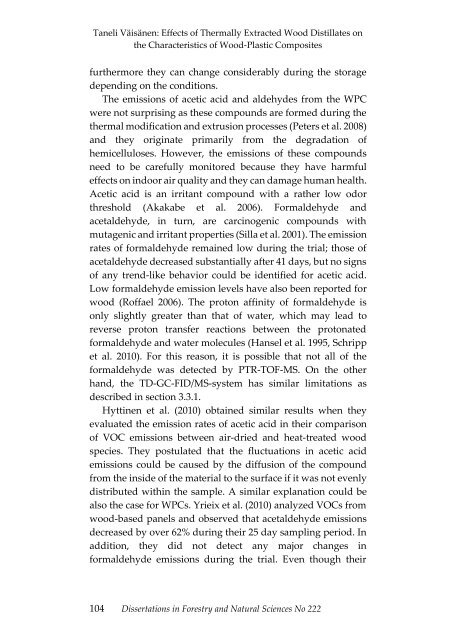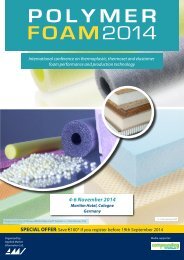Dissertations in Forestry and Natural Sciences
24lYKFN
24lYKFN
You also want an ePaper? Increase the reach of your titles
YUMPU automatically turns print PDFs into web optimized ePapers that Google loves.
Taneli Väisänen: Effects of Thermally Extracted Wood Distillates on<br />
the Characteristics of Wood-Plastic Composites<br />
furthermore they can change considerably dur<strong>in</strong>g the storage<br />
depend<strong>in</strong>g on the conditions.<br />
The emissions of acetic acid <strong>and</strong> aldehydes from the WPC<br />
were not surpris<strong>in</strong>g as these compounds are formed dur<strong>in</strong>g the<br />
thermal modification <strong>and</strong> extrusion processes (Peters et al. 2008)<br />
<strong>and</strong> they orig<strong>in</strong>ate primarily from the degradation of<br />
hemicelluloses. However, the emissions of these compounds<br />
need to be carefully monitored because they have harmful<br />
effects on <strong>in</strong>door air quality <strong>and</strong> they can damage human health.<br />
Acetic acid is an irritant compound with a rather low odor<br />
threshold (Akakabe et al. 2006). Formaldehyde <strong>and</strong><br />
acetaldehyde, <strong>in</strong> turn, are carc<strong>in</strong>ogenic compounds with<br />
mutagenic <strong>and</strong> irritant properties (Silla et al. 2001). The emission<br />
rates of formaldehyde rema<strong>in</strong>ed low dur<strong>in</strong>g the trial; those of<br />
acetaldehyde decreased substantially after 41 days, but no signs<br />
of any trend-like behavior could be identified for acetic acid.<br />
Low formaldehyde emission levels have also been reported for<br />
wood (Roffael 2006). The proton aff<strong>in</strong>ity of formaldehyde is<br />
only slightly greater than that of water, which may lead to<br />
reverse proton transfer reactions between the protonated<br />
formaldehyde <strong>and</strong> water molecules (Hansel et al. 1995, Schripp<br />
et al. 2010). For this reason, it is possible that not all of the<br />
formaldehyde was detected by PTR-TOF-MS. On the other<br />
h<strong>and</strong>, the TD-GC-FID/MS-system has similar limitations as<br />
described <strong>in</strong> section 3.3.1.<br />
Hytt<strong>in</strong>en et al. (2010) obta<strong>in</strong>ed similar results when they<br />
evaluated the emission rates of acetic acid <strong>in</strong> their comparison<br />
of VOC emissions between air-dried <strong>and</strong> heat-treated wood<br />
species. They postulated that the fluctuations <strong>in</strong> acetic acid<br />
emissions could be caused by the diffusion of the compound<br />
from the <strong>in</strong>side of the material to the surface if it was not evenly<br />
distributed with<strong>in</strong> the sample. A similar explanation could be<br />
also the case for WPCs. Yrieix et al. (2010) analyzed VOCs from<br />
wood-based panels <strong>and</strong> observed that acetaldehyde emissions<br />
decreased by over 62% dur<strong>in</strong>g their 25 day sampl<strong>in</strong>g period. In<br />
addition, they did not detect any major changes <strong>in</strong><br />
formaldehyde emissions dur<strong>in</strong>g the trial. Even though their<br />
104 <strong>Dissertations</strong> <strong>in</strong> <strong>Forestry</strong> <strong>and</strong> <strong>Natural</strong> <strong>Sciences</strong> No 222



